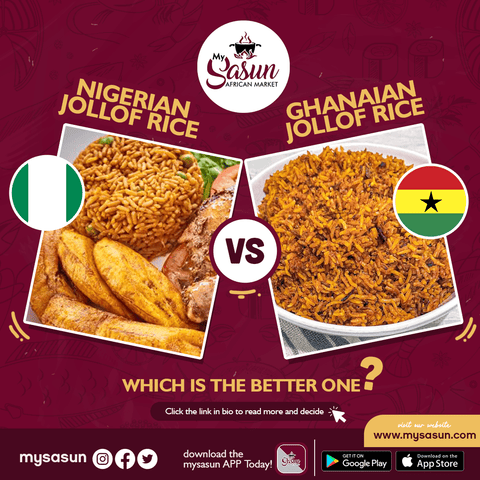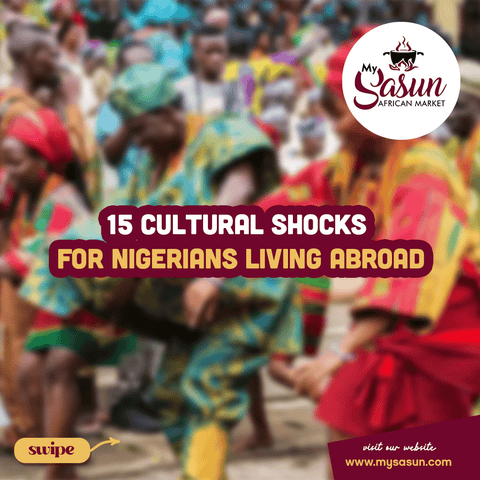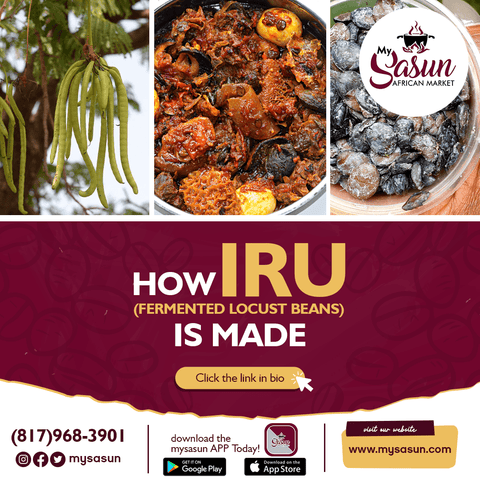Ghana and Nigeria are two passionate West African countries that seem to enjoy hating on each other (Haha). On the social media, they have had several ‘wars’ and debates on which country is better at making specific foods or which is better at football, government etc. But one unending war between these two beautiful nations would be about who makes the best Jollof Rice.

WHAT IS JOLLOF RICE?
Jollof rice is a burnt-orange colored rice dish popular in the Western countries of Africa. It is such a special meal that rarely would a party be thrown, or an event organized in these countries without Jollof Rice being one of the main event meals. To show you how seriously West Africans, especially Nigerians and Ghanians take Jollof rice, there is even an International Jollof Day! Haha, I kid you not!
For this meal, the cooking process is intricate and the order in which you add the ingredients also matters.
To prepare this sumptuous meal, long grain rice are cooked in a pot of rich, spicy tomato sauce and delicious stock. It is commonly paired with chicken, fish cuts, plantain, vegetable salad and so on.
ORIGIN OF JOLLOF RICE
Jollof Rice is believed to have originated from Senegal, Mauritania and Gambia. These countries have an ethnic group known as Wolof and Jollof is believed to be a modified name of that group. In these countres however, Jollof Rice isn’t known as Jollof Rice. It is known as Benachin or Thieboudienne and there is a main difference in the way of preparation. Theirs are cooked with fish and vegetables. So, while Jollof Rice can be traced to these countries, we can see that as the dish travelled across the West African region, there were modifications to the name and to the methods of preparation.

DIFFERENCES BETWEEN NIGERIAN & GHANA JOLLOF
While the Nigerian and Ghanaian jollof rice use similar ingredients, they both differ in taste and flavor. Nigerian jollof rice is cooked with long-grain parboiled rice, with the main spices being ground tomato, tomato paste, stock, curry powder, thyme, white pepper and bay leaves. Ghanaian Jollof is however cooked with perfumed Thai jasmine rice. This is where the main difference lies because this rice offers a different kind of smell and taste to the Jollof.
Then, the Ghanaian jollof uses more spices than its Nigerian counterpart. For example, ginger and garlic are blended into the pepper base for the Jollof sauce. They also use nutmeg, rosemary, anise, as well as mixed vegetables.
The Nigerian Jollof rice is served with meat and other sides like fried plantain, Nigerian salad, coleslaw, moimoi etc while the Ghana jollof rice is served with Shito as toppings, then, fried plantain, meat or fish as sides.
Also, among Nigerians, there’s a consensus that the rice should be burnt just a little to allow for crispiness at the bottom. Many people scurry for the 'bottom pot' of the Jollof Rice pan because it is usually crispy and flavourful. Ghanaian Jollof Rice is usually less smoky and less attention is given to a little part of it being burnt or not.
For the smoky effect, the Nigerian Jollof rice applies a longer cooking process than the Ghanaian Jollof rice. This reacts with the tomato for a smoky, ashy and roasted tomato note giving a savory and delightful character to the rice.
Also, the Ghanaian Jollof has a higher tomato flavor composition and uses less chilies since Ghanaians love tomatoes in their various forms.
ANY SIMILARITY BETWEEN THE NIGERIAN JOLLOF RICE AND THE GHANAIAN JOLLOF RICE?
The ingredients are similar. The processes of making them are similar. Except for the different kinds of rice being used, the smoky effect of the Nigerian Jollof, the additional ingredients that Ghana uses, the main similarity between these two methods of cooking jollof rice is the seasoning of the meat that is to be used to enjoy the rice. This determines the quality and maturity of the meat stock and the ultimate flavor and taste of the rice.

INGREDIENTS FOR MAKING THE NIGERIAN JOLLOF RICE
- 4 big Tomatoes
- 2 Onions
- 2 Red bell pepper
- 8 Scotch bonnet peppers
- Oil
- 2 Tomato paste sachets
- Curry powder
- Dried thyme
- Bay leaves
- Stock (Beef/chicken)
- 3 Stock cubes
- 6 cups of long grain rice
- Salt
HOW TO MAKE THE NIGERIAN JOLLOF RICE
Step 1: Wash the tomatoes, peppers and onions. Blend two tomatoes the peppers and one onion. Set the tomato mix aside.
Step 2: Wash the rice repeatedly until the water is clean. Pour in a sieve and allow to drain.
Step 3: Chop the remaining onion and tomatoes thinly.
Step 4: Heat the oil in a pan and introduce the chopped tomatoes. Stir slightly until the onions start to brown.
Step 5: Add the blended tomato mix. Then, add curry powder, thyme, stock cubes, and bay leaves into the pan. Stor together and allow to cook for 15 minutes.
Step 6: Add the tomato paste and the sliced tomatoes and allow to simmer on low heat until the moisture reduces significantly and the oil can be seen settling on the surface.
Step 7: Add the drained rice and the stock. Stir evenly and taste for salt. Add two cups of water and cover the pot. Allow to cook for 15 minutes.
Step 8: Stir through with a wooden spoon, reduce the heat to lowest and cover with a foil paper for the remaining moisture in the rice to be absorbed.
Step 9: Remove from heat when the rice is cooked. Stir through with a wooden spoon and cover. Your yummy Nigerian Jollof Rice is ready!
ALSO READ: 5 TYPES OF NIGERIAN PEPPER SOUP YOU SHOULD TRY
INGREDIENTS FOR MAKING THE GHANAIAN JOLLOF RICE
- 4 big Tomatoes
- 2 Onions
- 2 Red bell pepper
- 8 Scotch bonnet peppers
- Oil
- Garlic
- Fresh ginger
- 2 Tomato paste sachets
- Curry powder
- Dried thyme
- Bay leaves
- Stock (Beef/chicken)
- Nutmeg
- Bay leaves
- 3 Stock cubes
- 6 cups of Perfumed Thai rice
- Salt
HOW TO MAKE THE GHANAIAN JOLLOF RICE
We will repeat the same steps above with a slight variation.
Step 1: Wash the tomatoes, peppers and onions. Blend the tomatoes, the peppers, garlic, ginger, and onion. Set the mix aside.
Step 2: Wash the perfumed rice repeatedly until the water is clean. Pour in a sieve and allow to drain.
Step 3: Chop the remaining onion thinly
Step 4: Heat the oil in a pan and introduce the chopped tomatoes. Stir slightly until the onions start to brown
Step 5: Add the tomato paste and reduce the heat. Use a wooden spoon to stir while it fries for 5 mins.
Step 6: Add the tomato mix, curry powder, nutmeg, bay leaves, stock cubes and salt. Stir with a wooden spoon. Cook for 20 minutes or until you can see oil instead of water settling on the surface.
Step 7: Add the stock and rice into the fried sauce. Add 1 cup of water, taste for salt and add more if needed. Allow the rice to come to a boil, then reduce the heat.
Step 8: Place a sheet of aluminium foil over the rice, then cover the pan. Stir occasionally.
Step 9: Check after 10 mins and stir the rice with a wooden spoon. Let it cook on low heat for 15 minutes. Remove the pot from the heat, stir evenly.
Step 10: Remove from heat, stir with a wooden spoon, put the lid back on and leave for a few minutes before serving.
ALSO READ: VARIOUS NIGERIAN RICE RECIPES FOR DIFFERENT OCCASIONS
ROUNDING OFF:
With just a slight difference in preparation, you can see why Jollof Rice is a big deal to these two African countries, right? Jollof is more than just the ingredients. When well cooked rice and spicy sauce meet, the result is usually the bomb!
If you’re at a party in Nigeria or Ghana, you don’t have to search too long for jollof rice. It finds you. In some cases, you have to be proactive and go after it, because it’s usually the first dish to get maxed out. Haha
As the argument about who has the best jollof continues and appears to be never ending, maybe the answer doesn’t really matter, because a plate of any type of Jollof rice will always be a treat! When you get to hold the a spoon each of the dishes, you can decide for yourself the winner or the loser; the good and the better one.
Let me know your thoughts in the comments below.







Comments (4)
Am here to let the whole world know that I was diagnose of herpes 3 years ago where all hope was lost and I had nothing to do about it,I just accepted the faith that one day I will cure of this disease and I just pray everyday for a helper and one day my sister introduce me to a herbal doctor man called Dr ahonsie that she saw him on internet well I contact him on his email,I was not fully convinced until he sent me the herbal medicine which he ask me to take for two weeks I took it with faith and i went for a retest in different hospitals and today am cured of this disease and am also using this medium to let all those having STD,like herpes and the rest not to give up,their is a man who can cure you,his name is Dr ahonsie . contact the great herbalist via his Email: drahonsie00@gmail.com / WhatsApp: +2348039482367. https://drahonsie002.wixsite.com/dr-ahonsie
Hello everyone, i have a very important information about herpes virus, i was a victim of hsv1&2 until i met doctor Ahonsie, it still feels like a dream to me. it has been two years now, i have not experience any breakout of herpes. I new about him through a post made on social media, a lady shares her experience and then i decided to contact him and ever since i contacted i was encourage and with no doubt i was cured from herpes simplex in just two weeks. He also treat other illnesses like HPV, HIV, CANCER, THYRIOD, PENIS ENLARGEMENT, and more contact him via Email: drahonsie00@gmail.com / WhatsApp: +2348039482367. https://drahonsie002.wixsite.com/dr-ahonsie https://www.facebook.com/drstellaherbalhome?mibextid=ZbWKwLThanks
I thought the physicians says there is no cure for HSV 2!!! I am telling you today that Dr ahonsie cure HSV 2 with his herbal medicine and once you get cured you are cured forever it is never reversible, I have been suffering for this deadly disease called h HSV 2 for more than a 2years and lost all hope because my doctor says there is no cure for HSV 2. Brethren I saw a testimony on the internet on how Dr ahonsie cure HSV, Hapatitis etc with his herbal medication and an email and watsapp to contact him was also displayed, I thought this was joke but I decided to contact him and he replied telling me not to worry that my problem is over . Dr ahonsie sent me a herbal medication to drink for one month but only 2weeks I feel strange and I went to my doctor and he confirmed me negative. He can help you too. Contact him drahonsie00@gmail.com or whatsapp +2348039482367 https://drahonsie002.wixsite.com/dr-ahonsie https://www.facebook.com/drstellaherbalhome?mibextid=ZbWKwL
Being the winner of a multi-million-dollar lottery certainly is a life-changing event for almost every single lottery winner. My name is Mavis Wanczyk from Chicopee, Massachusetts, the famous Powerball lottery winner of $758 million (£591m). I know many people would wonder how I had won the lottery. Would you believe me if I told you that I did it with spell casting? I met this famous spell caster known as Great Odunga and he was the one who did it for me. As shocking as it was to me, my famous comment to the press was “ I’m going to go and hide in my bed.” Never did I believe that Great Odunga made me wealthy overnight. If you want to have your chance of winning and becoming very wealthy just like me, contact Great Odunga at odungaspelltemple@outlook.com OR Email: odungaspelltemple@gmail.com and WHATS-APP HIM at +2348167159012 and you will be lucky. Thanks for reading and hope to see you at the top